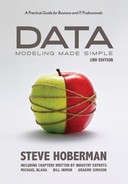Book Description
Data Modeling Made Simple will provide the business or IT professional with a practical working knowledge of data modeling concepts and best practices. This book is written in a conversational style that encourages you to read it from start to finish and master these ten objectives:
1. Know when a data model is needed and which type of data model is most effective for each situation
2. Read a data model of any size and complexity with the same confidence as reading a book
3. Build a fully normalized relational data model, as well as an easily navigatable dimensional model
4. Apply techniques to turn a logical data model into an efficient physical design
5. Leverage several templates to make requirements gathering more efficient and accurate
6. Explain all ten categories of the Data Model Scorecard
7. Learn strategies to improve your working relationships with others
8. Appreciate the impact unstructured data has, and will have, on our data modeling deliverables
9. Learn basic UML concepts
10. Put data modeling in context with XML, metadata, and agile development
Table of Contents
- Acknowledgements
- Foreword
- Read me first!
- SECTION I Data Modeling Introduction
- CHAPTER 1 What is a data model?
- CHAPTER 2 Why do we need a data model?
- CHAPTER 3 What camera settings also apply to a data model?
- SECTION II Data Model Components
- CHAPTER 4 What are entities?
- CHAPTER 5 What are attributes?
- CHAPTER 6 What are relationships?
- CHAPTER 7 What are keys?
- SECTION III Conceptual, Logical, and Physical Data Models
- CHAPTER 8 What are conceptual data models?
- CHAPTER 9 What are logical data models?
- CHAPTER 10 What are physical data models?
- SECTION IV Data Model Quality
- CHAPTER 11 Which templates can help with capturing requirements?
- CHAPTER 12 What is the Data Model Scorecard®?
- CHAPTER 13 How can we work effectively with others?
- SECTION V Essential Topics Beyond Data Modeling
- CHAPTER 14 What is unstructured data?
- CHAPTER 15 What is UML?
- CHAPTER 16 What are the Top 5 most frequently asked modeling questions?
- Suggested Reading
- Answers to Exercises
- EXERCISE 1: Educating Your Neighbor
- EXERCISE 3: Choosing the Right Setting
- EXERCISE 5: Assigning Domains
- EXERCISE 6: Reading a Model
- EXERCISE 7: Clarifying Customer Id
- EXERCISE 9: Modifying a Logical Data Model
- EXERCISE 10: Getting Physical with Subtypes
- EXERCISE 11: Building the Template
- EXERCISE 12: Determining the Most Challenging Scorecard Category
- Glossary
- Index
